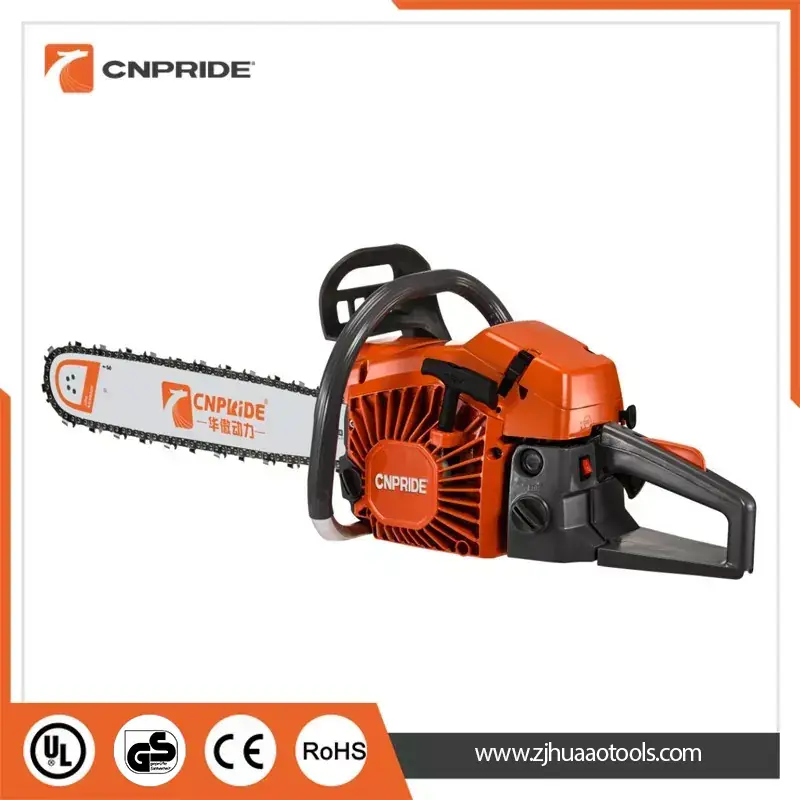Safety Precautions When Operating a Gasoline Chain Saw
2025-04-03
Operating a gasoline chain saw can be hazardous if proper safety measures are not followed. Here are essential safety precautions to ensure both the operator’s and others' safety:
1. Wear Protective Gear:
- Helmet with Face Shield/Protective Glasses: Protect your head and face from falling debris and sawdust.
- Ear Protection: Gasoline chain saws can be loud, and prolonged exposure can damage hearing. Wear earplugs or earmuffs to protect your ears.
- Cut-Resistant Clothing: Wear chainsaw protective pants or chaps made from cut-resistant material to protect your legs in case of accidental contact with the chain.
- Gloves: Wear cut-resistant gloves to protect your hands from sharp edges and debris.
- Steel-Toe Boots: Protective boots with steel toe caps and slip-resistant soles will help shield your feet and provide stability.

2. Inspect the Chain Saw Before Use:
- Check the Chain Tension: Ensure that the chain is properly tensioned to avoid it coming loose during use.
- Inspect the Bar and Chain: Make sure the chain is sharp and properly lubricated. Check for damage or wear on the guide bar.
- Examine the Safety Features: Ensure that the chain brake, throttle lock, and other safety mechanisms are functioning correctly.
- Fuel Check: Verify the fuel mixture (gasoline and oil) is correct, and ensure no fuel leaks or spills are present.
3. Proper Starting Procedure:
- Always start the chain saw on the ground, not while holding it in the air.
- Keep the chain brake engaged while starting the saw to prevent accidental movement of the chain.
- Make sure your feet are firm on the ground and maintain a good stance to avoid losing balance.
4. Handling the Chain Saw Safely:
- Firm Grip: Always hold the chain saw with both hands for better control. Use the front handle with one hand and the rear handle with the other.
- Avoid Kickback: Kickback occurs when the tip of the chain saw hits an object and causes the saw to jerk backward. To reduce this risk:
- Always keep a firm grip and avoid cutting with the tip of the chain.
- Use the chain saw at waist height or slightly below for better control.
- Be cautious when cutting near the tip or at awkward angles.
- Stabilize Your Stance: Stand with your feet shoulder-width apart to ensure balance and stability while operating the saw.
5. Cutting Safety:
- Clear the Work Area: Before starting, make sure the area around you is clear of obstacles, debris, or other people.
- Avoid Overreaching: Keep both feet on the ground, and avoid cutting in positions where you are off balance or can’t control the saw properly.
- Work Slowly and Carefully: Do not rush through cuts. Let the saw do the work, and avoid forcing it through the wood.
- Be Mindful of the Chain's Direction: Always be aware of the chain's movement direction and avoid positioning your body in the path of the chain.
6. Safety Around Other People:
- Establish a Safety Zone: Always keep a 10-foot safety zone around you and the chain saw to ensure no one enters the danger zone while you are operating it.
- Warn Others: Let people nearby know you are about to start using the chain saw, and ensure they are at a safe distance.
7. Shut Off the Saw When Not in Use:
- Turn Off the Engine: Always turn off the chain saw when it is not in use, especially when walking from one area to another.
- Store Safely: When storing the saw, ensure that it’s stored out of the reach of children and that the chain brake is engaged.
8. Regular Maintenance:
- Sharpen the Chain: Regularly sharpen the chain to ensure it cuts effectively and reduces the risk of the saw binding in the wood.
- Clean the Air Filter: A clean air filter ensures the engine runs smoothly. Inspect and clean the air filter regularly.
- Check for Fuel Leaks: Inspect the fuel tank and lines for any signs of leaks to prevent potential hazards.
- Lubricate the Chain: Regularly check and top off the bar and chain oil to avoid friction and overheating.
9. Watch for Dangerous Conditions:
- Weather Conditions: Avoid using a gasoline chain saw in strong winds, heavy rain, or during thunderstorms. Wet or slippery conditions can make cutting difficult and increase the risk of accidents.
- Uneven Terrain: Never operate a chain saw on unstable or uneven ground where you may lose balance.
10. Know When to Seek Help:
- If you are unsure about your ability to safely use a gasoline chain saw, or if the work is beyond your skill level, hire a professional.
- If you feel fatigued or uncomfortable, stop and take a break.
Conclusion
Safety should always be the top priority when using a gasoline chain saw. By following these precautions, you can minimize the risk of accidents and injuries, ensuring efficient and secure operation. Always take the time to wear appropriate gear, inspect your equipment, and maintain control throughout the cutting process.


